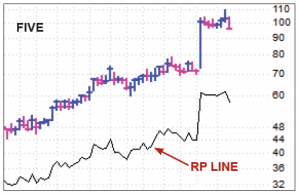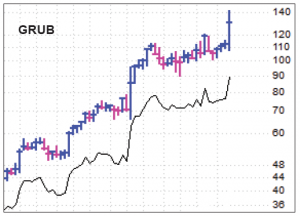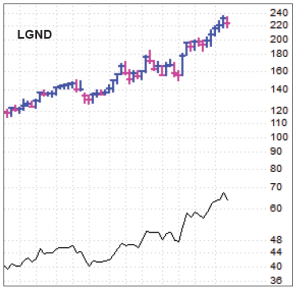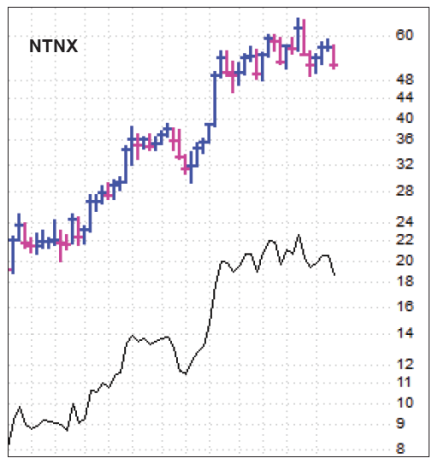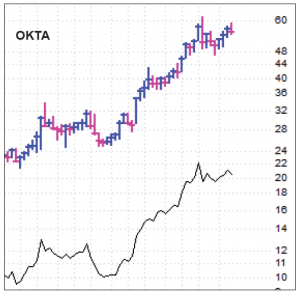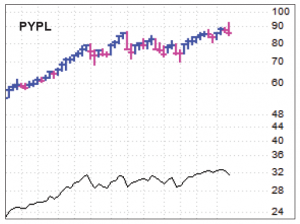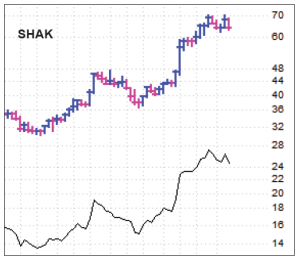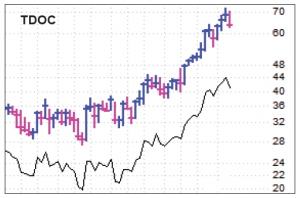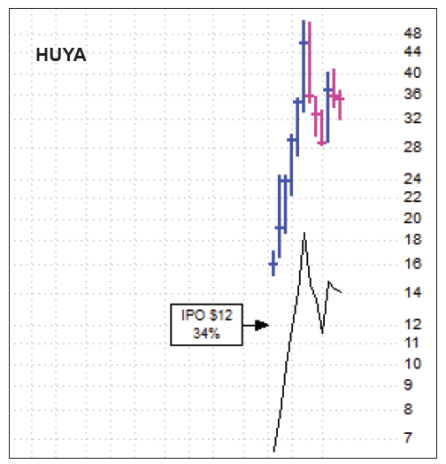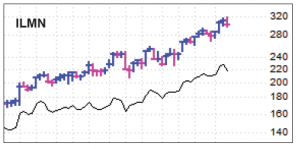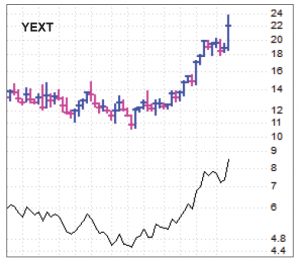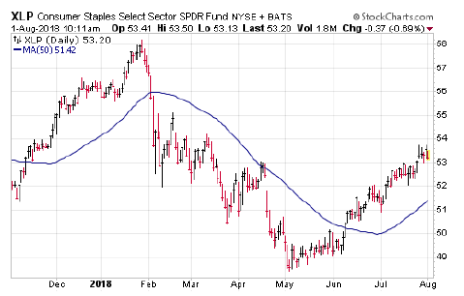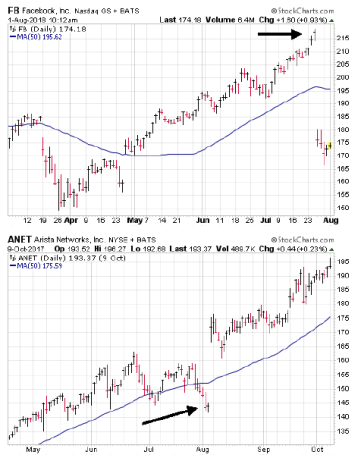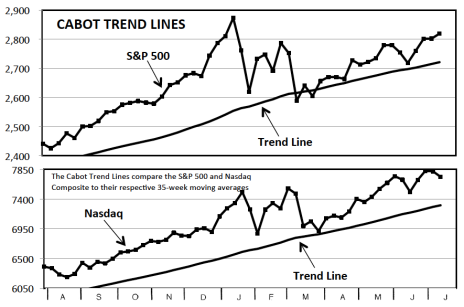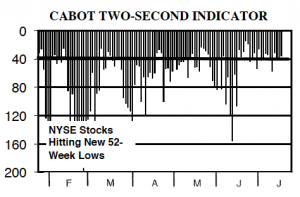The overall bull market remains in good shape, but the big event of the past two weeks has been the sharp selloff seen in many leading growth stocks that featured a bunch of abnormal selling. Could this dip be another shorter-term shakeout? Sure, and we’re certainly not sticking our heads in the sand. But the selling has been enough for us to trim our sails, raise some cash and see if the buyers can show some support.
Cabot Growth Investor 1399
[premium_html_toc post_id="155271"]
Growth Stocks Hit, Bull Market Fine
For most stocks, 2018 has been a slog, with financials, industrials, consumer staples, transports and other areas doing much more chopping than trending. Growth stocks, though, have been winners—growth-oriented indexes like the Nasdaq and S&P 600 SmallCap have done very well, and of course many individual issues have gone to the moon.
Whenever you get a situation like this—a relatively narrow group of institutional-quality names moving up, with the rest of the market acting sluggishly—there’s a higher-than-normal chance that a sharp reaction will take place. Sometimes that reaction is for the whole market to cave in.
But oftentimes, the outcome is violent rotation, which is what we’ve seen during the past two weeks—most of the leading growth stocks getting whacked while the lagging areas of the market have perked up. You can spend all day asking why, but why doesn’t matter. What really counts is the evidence in front of us, which, for the growth stock realm, has darkened considerably, with a bunch of stocks flashing abnormal selling. We’ve responded by raising some cash and putting most of our stocks on Hold.
“But Mike,” many might ask, “can’t this be just another short, sharp shakeout among growth stocks, like we saw in late June and a few other times this year, followed by another move higher?” Of course! There are still many growth stocks that, while falling sharply, have held key support, and we’ve seen a good number of encouraging earnings reactions, too.
And let’s not forget that the overall bull market is still very much intact (our Cabot Trend Lines are clearly bullish) and looks likely to continue—the last 11 times (going back to the 1930s) that the S&P rose every month from April through July, the rest of the year was up every time, with an average gain around 11% (hat tip to Ryan Detrick of LPL Financial for the info).
Thus, you shouldn’t stick your head in the sand. But you also shouldn’t be complacent—after a good run, many leaders have cracked their intermediate-term uptrends, which is a good reason to back off. From here, the key is to be flexible, ready to buy should the bulls show up but also ready to turn more cautious if growth stocks remain under pressure.
[highlight_box]WHAT TO DO NOW: Trim your sails. In the Model Portfolio, we’ve sold one-third of Five Below and all of our shares in Nutanix (NTNX) and Proofpoint (PFPT) since our last issue, giving us a cash position of 42%. Details inside.[/highlight_box]
Model Portfolio Update
Flexibility is one of the keys to investing. In real life, things rarely change course on a dime, but the market has a history of doing just that. A week ago, most leading growth stocks were in good shape despite some yellow flags. But the past few trading days have been brutal and featured plenty of abnormal action.
Because of the yellow flags (and earnings season), we’re glad we held onto 20% cash coming into the recent maelstrom. And in recent days, we’ve been throwing positions overboard to boost our cash position, which came into today totaling 42%.
From here, we’re keeping an open mind given that the overall market is still in decent shape—the buying earlier this year and selling during the past week has been concentrated in growth stocks, with other pockets of the market mostly range bound. Thus, we’re not ruling out another leg up developing with some new leadership. But the bottom line is that the onus is on the bulls to halt the declines—until then, it’s best to tread carefully.
Current Recommendations
HOLD—Five Below (FIVE 97)—FIVE looked like it was ready to continue its run higher two weeks ago as it leapt out of a tight five-week base, but that move was quickly reversed. Combined with the weakness in growth stocks, we decided to sell one-third of our remaining shares, marking the second time we’ve booked partial profits in the name. While there are some trade war worries surrounding the stock (costs could theoretically rise if the U.S.-China trade spat gets ugly), we’re not overly concerned because (a) it’s theoretical at this point, (b) it’s not clear how much costs would rise and (c) its importance is dwarfed by the company’s outstanding and predictable longer-term story, driven by rapid store growth and a product array that shouldn’t be affected by ups and downs in the economy. All told, then, our longer-term conviction with FIVE is as strong as ever, but we’re also not going to ignore the stock’s big run (it’s basically doubled from its five-year breakout last November to its high in July) and the wobbly environment for growth stocks. That’s why we took a bit more off the table, but are planning to hold the rest through this correction and consolidation, thinking higher prices are likely down the road.
BUY—Grubhub (GRUB 125)—Grubhub released another fantastic quarterly report last week, reinforcing the view that the firm has a very long runway of growth ahead of it. Despite what’s usually a seasonally slow quarter, the firm’s sales (up 51%), earnings (up 92%), EBITDA (up 61%), active diners (up 70%) and average daily orders (up 35%) all topped expectations. But probably more encouraging than the figures (and the increased guidance that stemmed from it) was the conference call, where management sounded a very bullish tone. Some highlights: June is usually the weakest month of Q2 (summer vacation season, etc.), but this year it was the strongest and that momentum has carried into July; strength in new diner acquisitions is being seen across the country; the firm has expanded its delivery network by 70 markets so far this year, and is on pace to double its delivery footprint by year-end, and that will include two-thirds of all KFC and Taco Bell locations to support its game changing deal with Yum! Brands. Another interesting stat is that Grubhub’s own drivers now account for about one-quarter of the food sales through its platform, a figure that’s rising steadily. GRUB gapped up wildly on the news before sagging back toward the top of its recent base, which isn’t ideal but is reasonable given the growth stock selloff. In the near-term, a lot will come down to the action of growth stocks and the market, and the stock could easily rest for a bit after the pop. But we think GRUB’s unique, mass market growth story (and leading position in its market) will keep big investors (551 mutual funds now own shares, up from 420 a year ago) interested. For our part, we could look to add more shares if the market stabilizes and GRUB continues to act well. But right now, we advise just sitting tight if you already own some, though you could buy a small position around here if you’re not yet in.
BUY—Ligand Pharmaceuticals (LGND 222)—LGND took a good-sized whack along with everything else last Friday and this Monday, but the damage was continued—shares closed just below their 25-day line on Monday before bouncing. The firm is set to release results next Monday (August 6), but as we’ve written before, Ligand already preannounced results and forecasts for this year, so the odds of a major move are lessened (though it’s never impossible). Separately, we’ve gotten some questions about why LGND’s earnings are expected to fall 11% next year and if that portends bad things—our thought is no, because this year’s earnings are projected to soar due to a couple of one-time milestone payments it’s already received. There’s nothing that says Ligand can’t earn similar payments next year (these are rarely baked into estimates), and besides, the real key here is ongoing royalty payments, which should rise steadily as current treatments grow and as more new drugs using Ligand’s technology hit the market. A total meltdown from the stock and the market would probably have us cutting our loss, but we still see LGND as relatively early stage (just getting going in May after a long rest), and its resilient business model and decent stock action are encouraging. We’ll stay on Buy.
SOLD—Nutanix (NTNX 49)—Frankly, we still have high longer-term hopes for Nutanix for all the reasons we’ve covered in recent months—hyperconverged infrastructure is the next big technology and data center trend, and Nutanix is the leader. But the story is the story and the stock is the stock, and the fact is NTNX is showing some red flags, with its breakout in June quickly failing and with the stock now having made no net progress since March. If shares build a firm launching pad in the weeks ahead, we might revisit it, but with growth stocks under pressure, the stock lagging and with a loss, we sold on a Special Bulletin Monday evening and are holding the cash.
HOLD—Okta (OKTA 52)—OKTA is close to the edge for us, but despite its extremely sharp decline on Friday and Monday, the stock is actually a few percent above its late-June low (near 48). That doesn’t mean the action is encouraging—the big-volume earnings reversal in June, the low-volume rally in July and this recent plunge don’t inspire confidence. Still, rules are rules, and with more than 40% of cash already on the sideline, we’re sticking with a mental stop in the upper 40s—above there, we’ll give the stock a chance, especially with the longer-term trend still up. But renewed weakness (likely caused by another wave of selling in growth stocks) will have us abandoning ship.
HOLD—PayPal (PYPL 83)—Our thoughts on PYPL are similar to our thoughts on most growth stocks: Intermediate-term, the trend is broken, with a recent failed breakout (a bug seen in many charts these days) likely to lead to another consolidation, though longer-term, the trend is still up and the stock has held key support (30-week line this week, for instance). Fundamentally, the second-quarter earnings report confirmed that business remains on a fast and steady growth track—sales (up 23%) and earnings (up 28%) looked fine, as did the 15% increase in total accounts (now 244 million, including 19.5 million merchants), the 27% hike in total payment volume (including a 78% jump in Venmo’s volume), a 9% increase in payments per account and another huge mound of free cash flow. Of course, our leash isn’t limitless, but having already taking partial profits a few months back and with a modest-sized position, we’re giving our stake some room to find support.
SOLD—Proofpoint (PFPT 113)—Many times during the past year our patience has paid off, as we’ve held onto a stock for three, four or five months of ups and downs before it finally gets going. (Five Below was a perfect example of this.) But Proofpoint didn’t offer us any reward for our endurance—the stock fell sharply after earnings last Friday despite a seemingly beat-and-raise report; a lot of it was probably due to the market plunge that day. Yes, the story still seems solid, but PFPT has now been rejected in the high 120s multiple times, with this big-volume plunge raising the likelihood of a top. (It doesn’t help that most cybersecurity stocks have cracked key support.) We sold on a Special Bulletin Monday morning.
HOLD—Shake Shack (SHAK 62)—SHAK has gotten hit with everything else, sliding below its 50-day line on Monday. But we still have a profit, and really, the next big move will likely come down to earnings, which are due out Thursday (August 2) after the close—analysts are expecting revenues of $111 million (up 22%) and earnings of 18 cents per share (actually down a bit from last year, but they’re usually quite conservative), but a lot of focus will be on same-store sales trends and the outlook, too. Encouragingly, while some high-growth retailers like SHAK have been hit, the group is holding up very well, and we still consider this to be an early-stage situation after May’s monstrous gap up. If the stock gets clobbered, we’ll cut our loss, but right here we’re holding on and will see what comes on earnings.
HOLD—Teladoc (TDOC 62)—The combination of a share offering (much of which was used to buy Advance Medical, which dramatically expanded the company’s presence overseas) and the collapse in growth stocks has dented TDOC—it’s gone from shooting ahead to new highs to testing its 50-day line in just a few days. Big picture, we believe the initial breakout here came just in early May, so many big investors are likely wanting to accumulate on dips. That said, similar to SHAK, the intermediate-term outlook is going to have a lot to do with earnings, which for TDOC are due out tonight after the close—analysts see revenues rising 107% to $92.4 million, with a loss of 37 cents per share, but all of the sub-metrics (user growth, number of virtual visits) and any outlook with Advance Medical now in the fold will be key as well. We switched our rating to Hold earlier this week, and will see how it looks post-earnings.
Watch List
Canada Goose (GOOS 57): GOOS has had a big run this year so it might need more time to rest. But we think its giant gap up in June was due to big investors thinking the firm’s product line expansion (from just winterwear to spring and knitwear, too) is dramatically expanding the growth potential. Shares bounced off their 50-day line this week.
Carvana (CVNA 44): CVNA still looks great—it basically had one bad day, never touched its 50-day line and has begun to bounce. This story is huge and likely early-stage. Earnings are due out August 8.
Spotify (SPOT 180): SPOT reported a fine quarter last week, with 180 million active users (up 30%) and 83 million premium subscribers (up 40%), driving 34% gain in revenues on a currency-neutral basis. The stock remains north of its 50-day line, which is impressive.
Stitch Fix (SFIX 29): It’s young and volatile, but SFIX is the leader in a brand new industry (online personal stylist), is profitable, showed three giant-volume up weeks in June and is north of its 50-day line. We’re intrigued.
Vertex Pharmaceuticals (VRTX 178): VRTX’s quarterly report was excellent, mainly thanks to better-than-expected sales of its recently launched CF drug. The stock has chopped around but remains in good shape—a push above 183 (and a better environment for growth stocks) would be very bullish.
Other Stocks of Interest
The stocks below may not be followed in Cabot Growth Investor on a regular basis. They’re intended to present you with ideas for additional investment beyond the Model Portfolio. For our current ratings on these stocks, see Updates on Other Stocks of Interest on the subscriber website or email mike@cabotwealth.com.
Diamondback Energy (FANG 133) — With more than 207,000 net acres in the Permian basin of Texas, explorer/driller Diamondback Energy is a pure play on that hugely productive oil & gas production area. While the company is sensitive to energy prices, it has also grown its pre-expense earnings per share over 700% from its IPO despite a 28% dip in oil prices during the same period. The secret is the company’s rigorous approach to cost controls, which, combined with the mind-boggling productivity of its acreage, can keep the company profitable even below $50 per barrel oil. The company is working hard toward connecting its wells to pipelines that connect to the Gulf ports of Houston and Corpus Christi, Texas, with total exposure to Gulf pricing expected by 2020. If oil stocks go, FANG should do very well.
HUYA Inc. (HUYA 34) — It used to be that Chinese consumers loved to watch sports and play video games. But now it seems that they also love to watch video games. HUYA Inc. is a Chinese leader in live streaming video games, especially e-sports events that appeal to game enthusiasts. With streaming technology in place, HUYA also has the potential to offer its platform to broadcasters and talent agencies to air their content. The company has just turned profitable and has booked five straight quarters of triple-digit revenue growth, with EPS up 110% in Q4 2017 and 350% in Q1. The company will report its Q2 results on August 13 after the market closes, and the stock, which came public just in May, could react strongly to the news, whether it’s good or bad. But some recent high-volume buying days may be a clue that the whales are getting interested.
Illumina (ILMN 323) — Founded in 1998, Illumina is a giant in the analysis of the human genome. In fact, more than 90% of all the DNA sequencing ever done has been performed using Illumina’s technologies. DNA sequencing is vital in identifying inherited disease vulnerabilities, cancer diagnosis and treatment choices and other health concerns—plus consumer gene testing for family history has taken off in 2017. The company’s stock has been in a bumpy uptrend since the beginning of 2017, and pushed out to new all-time highs yesterday after a well-received quarterly earnings report that featured a 25% jump in revenue and a sterling 74% hike in earnings per share. ILMN dipped to its 50-day moving average on the day before earnings came out, so this spike higher on good volume is a very good sign.
Yext (YEXT 22) — With three times as many people seeking information about businesses via third party sites like Yelp, Grubhub, TripAdvisor and Google rather than the companies’ own websites, it has been hard for companies to control to manage the information they want to show the public. Yext gives businesses a way to manage their online information across all sites, giving them a consistent, positive identity. Yext is already signed up with the leaders in search, social media and local food, health and travel sites and got a big boost on July 25 when it announced a deal with Amazon to integrate its platform with Alexa. Yext isn’t expected to turn a profit for at least a couple of years, but with revenue growth clocking in at a steady 30%+ rate, the future looks pretty bright.
Defensive Stocks Make a Move
One of our favorite secondary market timing indicators is the action of defensive-oriented stocks compared to growth-oriented areas of the market. The theory is simple—after a good run for growth stocks, if you begin to see (a) growth stocks wobble and (b) defensive sectors pick up steam, it’s a good bet institutional investors are shifting into safer areas of the market, likely because they expect rocky times.
Remember, mutual funds and most pension funds remain close to fully invested at all times, so selling volatile growth stocks and accumulating stodgy names is their way of seeking shelter.
Our favorite measure of defensive stocks is the consumer staples fund (XLP), something I mention often in my Cabot Weekly Review videos. Whereas the group can get pushed by some macro factors (the U.S. dollar, interest rates), the stocks are sturdy, dividend payers and their businesses are safe—no recession is going to affect their sales much, if at all.
On the chart, you can see XLP had a good run late last year and early this year, but that wasn’t a warning sign; remember, the overall market was going bananas then, too. Then XLP slipped into a long period of underperformance through early May.
The recent action, though, is more concerning. XLP has rallied fairly persistently since early June, and during most of that time, the action of growth stocks was lackluster—and in recent days, of course, the sellers have stepped up and punished most growth stocks.
As a secondary indicator, the movement in XLP vs. growth stocks isn’t something we directly trade off of, and to be fair, we’re also seeing a good amount of buying in other beaten-down areas (industrials, financials), so it’s not just defensive-oriented stocks that are showing strength.
But, if nothing else, the XLP/growth stock action indicates a change in the market’s character. Where growth stocks were the clear leaders for most of this year (even when the major indexes were pulling back in the February-April time frame), the evidence suggests that buyers have moved elsewhere for now. If this pattern continues, it raises the odds that growth stocks have entered a correction and consolidation phase. It’s a measure worth watching.
Earnings Reactions are Hard to Predict
Whenever earnings season gets under way and brings with it the inevitable batch of gap ups and gap downs, we hear from some people wondering: Is there a way to predict the outcomes of earnings moves for our stocks?
It’s a fair question and one we put a lot of time studying back in the mid 2000s, when earnings gaps became more frequent. One thing we studied was how the stock acted right before a report, thinking it might give clues to what big investors might be hearing ahead of reports.
But what we found was actually an inverse correlation in many instances, something that continues to this day. For instance, look at Facebook (FB) right before last week’s big earnings plunge—the stock was not just acting well but running higher in the days since leading up to the report. Conversely, we frequently see stocks sag ahead of earnings only to soar—Arista Networks (ANET) was a perfect example a year ago, when shares were sliding to multi-month lows after a good-sized run before gapping up wildly.
That doesn’t mean that every earnings has a 50-50 chance of going either way. It turns out that many of the factors we always search for—a strong story, excellent growth numbers, an uptrending chart, a positive market environment and an early-stage setup (the stock’s original breakout was within the past six to nine months)—tend to correlate with positive earnings reactions, which is comforting.
But, at the end of the day, no matter what methodology you use, success comes not from trying to guess what comes next but practicing sound money management (proper position sizing, etc.) and sticking with a consistent plan that gives you the best chance. That’s the best method to not only survive (and occasionally thrive) during earnings season, but also to develop some bigger winners over time, which is what really makes the difference in your results.
Cabot Market Timing Indicators
The overall bull market is still very much intact, but the vicious rotation out of growth stocks during the past two weeks caused us to raise cash. With the market’s trends still OK, we’re not hiding in the storm cellar, but the onus is on the bulls to halt the declines in leading growth titles.
Cabot Trend Lines: Bullish
Our Cabot Trend Lines are still in great shape, which is a big reason not to get too negative. At the close of last week, both the S&P 500 (by 3.6%) and even the recently weak Nasdaq (by 5.9%) closed well above their respective 35-week moving averages, telling you the larger, longer-term uptrend remains in place. The odds continue to favor higher prices when looking months down the road.
Cabot Tides: On the Fence
Our Cabot Tides are back on the fence, as the leading indexes of the past few months (such as the S&P 600 SmallCap, shown here) have stalled out since mid June and are hovering around their lower (50-day) moving average. Of course, these indexes also aren’t far from new high ground; a couple of good days could change the landscape. But right here, the intermediate-term trend is neutral.
Two-Second Indicator: Neutral
The Two-Second Indicator isn’t giving an all-clear, but there’s no question it’s shown improvement—one glance at the chart to the left shows new lows hovering around 40 during the past month, compared to the monsoons of selling earlier in the year. It’s a plus, but we need to see a few straight days of sub-40 readings to conclude the broad market is in great health.
[premium_html_footer]
Send questions or comments to mike@cabotwealth.com.
Cabot Growth Investor • 176 North Street, Post Office Box 2049, Salem, MA 01970 • www.cabotwealth.com
All Cabot Growth Investor’s buy and sell recommendations are made in issues or updates and posted on the Cabot subscribers’ website. Sell recommendations may also be sent to subscribers as special bulletins via email and the recorded telephone hotline. To calculate the performance of the portfolio, Cabot “buys” and “sells” at the midpoint of the high and low prices of the stock on the day following the recommendation. Cabot’s policy is to sell any stock that shows a loss of 20% in a bull market (15% in a bear market) from our original buy price, calculated using the current closing (not intra-day) price. Subscribers should apply loss limits based on their own personal purchase prices.
Charts show both the stock’s recent trading history and its relative performance (RP) line, which shows you how the stock is performing relative to the S&P 500, a broad-based index. In the ideal case, the stock and its RP line advance in unison. Both tools are key in determining whether to hold or sell.
THE NEXT CABOT GROWTH INVESTOR WILL BE PUBLISHED AUGUST 15, 2018
We appreciate your feedback on this issue. Follow the link below to complete our subscriber satisfaction survey: Go to: www.surveymonkey.com/marketlettersurvey
Neither Cabot Wealth Network nor our employees are compensated by the companies we recommend. Sources of information are believed to be reliable, but are in no way guaranteed to be complete or without error. Recommendations, opinions or suggestions are given with the understanding that subscribers acting on the information assume all risks. © Cabot Wealth Network. Copying and/or electronic transmission of this report is a violation of U.S. copyright law. For the protection of our subscribers, if copyright laws are violated, the subscription will be terminated. To subscribe or for information on our privacy policy, call 978-745-5532, visit www.cabotwealth.com or write to support@cabotwealth.com.
[/premium_html_footer]



